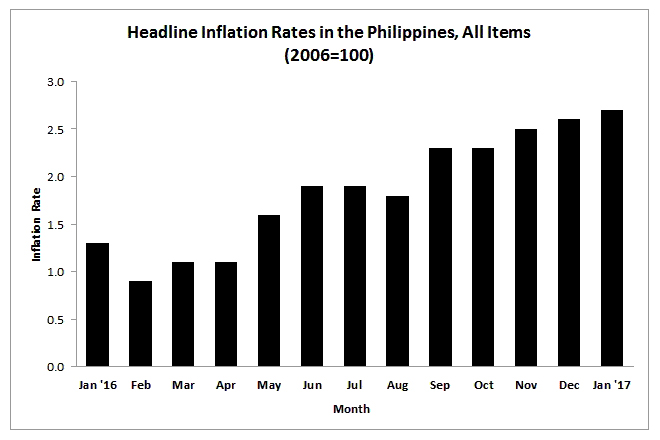(UPDATE) January inflation highest in two years
February 7, 2017
Philippine inflation was at its highest in two years as non-food items, like water, power, gas and other fuels, pushed it to 2.7 percent, the National Economic and Development Authority (NEDA) said in a statement Tuesday.
The inflation rate was within the government’s target range of three percent and within the central bank’s forecast range of 2.3-3.2 percent for the month.
On a year-ago basis, inflation was 1.3 percent in January 2016 and 2.6 percent in December 2016. Inflation had been rising since September’s 2.3 percent in 2016.
“Non-food items went up by 1.8 percent in January 2017 from 1.3 percent in December 2016, NEDA said..
“The faster spike in transport and gas and other fuels costs can be traced to the increase in petroleum prices as the oil market rebalances after the recent decision of the Organization of the Petroleum Exporting Countries to cut oil production by 1.2 million barrels per day,” said Socioeconomic Planning Secretary Ernesto Pernia.
Bangko Sentral ng Pilipinas Deputy Governor Nestor Espenilla, in a statement, said the central bank “will continue to closely monitor emerging price conditions to ensure price stability conducive to a balanced and sustainable economic growth.”
Food prices were lower for fruits, vegetables, meat, corn, sugar, jam, honey, chocolate and confectionery.
But, higher price adjustments were recorded for fish, and oils and fats. There was also a slight rise in the price of rice, which went up 1.8 percent in January 2017 from 1.6 in the previous month.
“The damage by typhoons Karen and Lando may have contributed to the lower supply of rice, which slightly raised rice prices. In some areas like Cagayan Valley and Central Visayas, the planting calendar was delayed, which resulted in lower production in the fourth quarter,” Pernia said.
Overall, inflation drivers are higher oil prices, pending petitions for higher electricity rates and transport fares, besides strong domestic demand, NEDA said.
Other price pressures are a shift to a unitary excise rate for cigarettes effective January 2017 as mandated by the Sin Tax Reform Law, and the Malampaya 20-day maintenance shutdown that started last month, which may lead to an increase in the generation charge starting March, NEDA said.
“Despite upside risks and pressures, the government expects inflation to be stable and remain consistent with the target of 2 to 4 percent,” said Pernia. DMS
Latest Videos
- THE UNTOLD STORY EXPERT INSIGHTS INTO THE UKRAINE
- NEGOTIATING A NEW ORDER US RUSSIA TALKS ON UKRAIN
- Ukraine: A Pawn in the Geopolitical Game? Will Trump Intervene?
- US VP VANCE CRITICIZES EUROPEAN DEMOCRACIES AT MUNICH SECURITY CONFERENCE
- UNCOVERING THE WEB OF DECEIT: CIA INFILTRATION OF THE MEDIA
- SHIFTING SANDS: TULSI GABBARD’S CONFIRMATION AND THE EVOLVING GLOBAL LANDSCAPE
- FAUCI SCANDAL: A THREAT TO GLOBAL HEALTH AND DEMOCRACY






